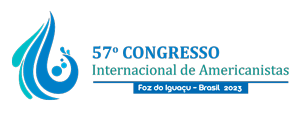| Dados do autor | |
|---|---|
| Sua instituição | University of Toronto U of T |
| País de origem do autor | Canadá |
| Dados co-autor(es) [Máximo de 2 co-autores] | |
| Email escondido; Javascript é necessário. | |
| Nome completo | Luis Manuel González La Rosa |
| Sua titulação | Doctor's Degree Student |
| Titulação | Undergraduate |
| País de origem do co-autor | Peru |
| Instituição | Archaeology Centre, University of Toronto U of T |
| Nome completo | Kelly J. Knudson |
| Email escondido; Javascript é necessário. | |
| Titulação | Doctor |
| Instituição | Arizona State University ASU |
| Proposta de Paper | |
| Área Temática | 02. Arqueología |
| Grupo Temático | Prácticas agro-pastoriles en la macro-región andina: evaluando su heterogeneidad desde los últimos avances metodológicos y marcos interpretativos |
| Título | Exploring Animal Life Histories through Isotope Analyses and Camelid Age: Agropastoral Strategies at the End of Moche on the North Coast of Peru (CE600-1000) |
| Resumo | The expanding specialization of isotope analyses in zooarchaeology has provided great insights into animal management of past societies. On the north coast of Peru seminal work has revealed local husbandry practices during the Early Intermediate Period (200BCE-CE200). However, less research has been conducted on the beginning of the Middle Horizon (CE600-1000) to understand the impact of shifting sociopolitical relations on animal management strategies. This paper explores the social and environmental instability of the Late Moche period (CE650-900) through stable and radiogenic isotope analyses of camelid remains from the sites of Huaca Colorada and Tecapa in the Jequetepeque Valley. The isotope samples are from llama and alpaca remains that have been identified into age categories through tooth eruption, dental wear and long bone epiphyseal fusion. By examining camelid age profiles, isotopic variation and intra-site camelid access, this paper provides a compelling methodological framework to examine the life histories of herd animals. We argue that social inequality experienced by communities at Huaca Colorada were manifested in their selection of non-local camelids by elites in large feasting events. The offering of long-distant herded camelids from other coastal and highland origins facilitated the sociopolitical negotiations between Moche, Cajamarca and Wari cultural spheres. In the end, novel theoretical perspectives need to be considered to interpret the role of nonhuman animals in the social networks and political realities of past societies. |
| Palavras-chave | |
| Palavras-chave |
|
